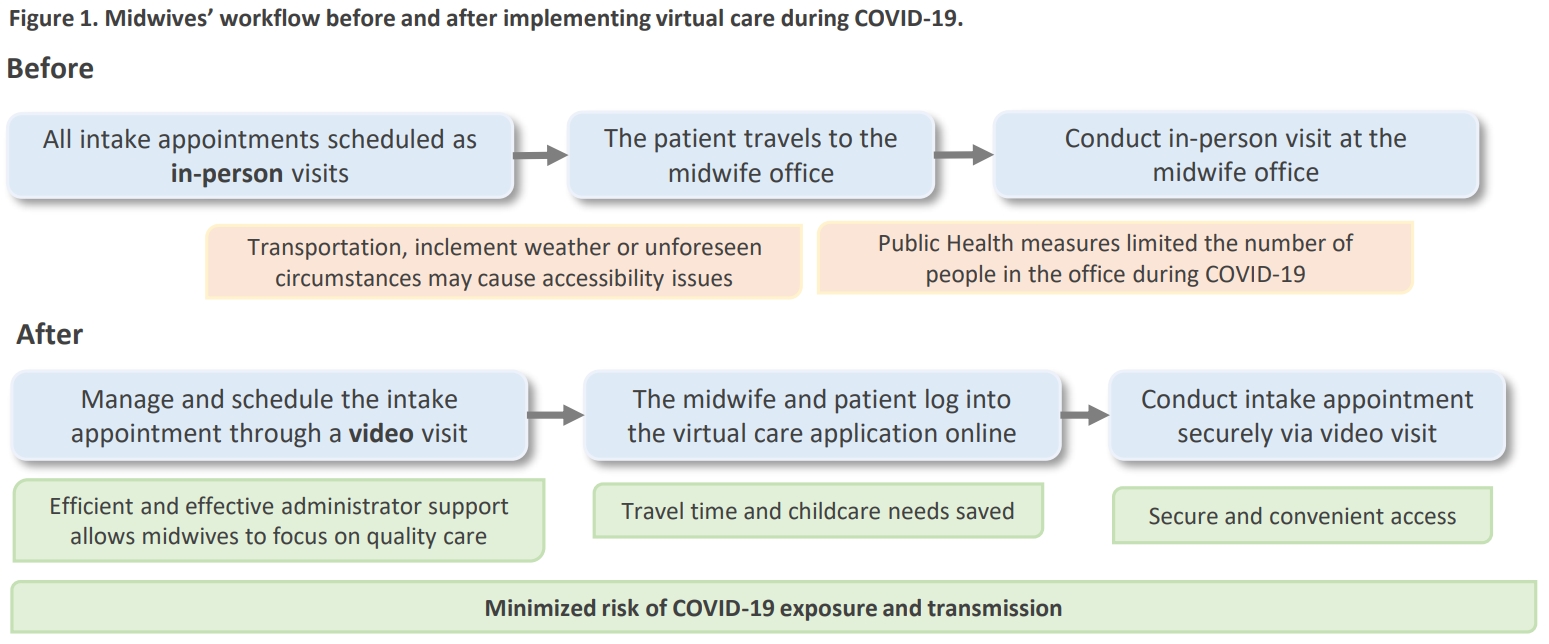Virtual Care: A case study on a midwifery perspective on video visits
In response to the increased cases of the novel coronavirus (COVID-19) disease, providers throughout the healthcare system have embraced virtual care approaches as an alternative to face-to-face visits in order to reduce the risk of COVID-19 transmission. While not a replacement for in-person visits, virtual care has been shown to facilitate and complement existing patterns of care.1 Midwives play a major role for pregnant and post-partum patients, and for newborns in their first six weeks of life.2 The first midwifery appointment is the longest, usually lasting sixty minutes, and includes a detailed history-taking, education regarding the midwifery model of care, and informed choice discussion regarding prenatal screening. During this appointment, the midwife establishes a personal relationship with the expectant parent, initiating continuity of care from early pregnancy to six weeks after birth.
Key takeaways
Virtual care enables midwives to connect with expectant mothers and conduct the intake appointment via video using a secure virtual care platform. Virtual care seamlessly integrates into midwifery workflows, providing uninterrupted service while reducing the risk of COVID-19 exposure and transmission, and facilitating provision of family-centered maternity care.
There is evidence that pregnant women are at an increased risk for severe illness from COVID-19 compared to those who are not pregnant. 3,4 Virtual care offers an opportunity to reassess and revise the number of face-to-face contacts while reducing the risk of COVID-19 transmission. With change management support from the eHealth Centre of Excellence in March 2020, Blue Heron Midwives adopted virtual care, with administrator support that managed the scheduling of intake visits for six midwives.

Video visits have met our needs to safely and efficiently facilitate the new patient intake process for midwifery care. The intake visit typically takes an hour to thoroughly gather information, provide education and begin to develop a relationship. Prior to the pandemic, we would spend this hour in-person with the patient, and possibly their partner and children.
During COVID-19, regular office visits have been shortened and the pregnant person is required to attend alone. OTN intake visits allow us to meet the patient unmasked (and their family, if they wish) and to maintain the unhurried nature of our intake appointment. One added benefit is that it relieves them of the burden of finding childcare for this initial visit. Our team found it easy to adjust to offering OTN eVisits, and still allows us to maintain high quality patient care.
Ann Liebau, Registered Midwife
Blue Heron Midwives
In accordance with the recommendations from the World Health Organization5 and the Association of Ontario Midwives5, virtual care supported the midwifery clinic to limit the number of people inside the clinical office while enabling delivery of care to mothers-to-be during COVID-19. Since March 2020, Blue Heron Midwives converted 100% of new patient intake appointments to video visits, allowing initiation of care to expectant mothers. While in-person visits are still available, video visits support the midwife to continue to provide care throughout pregnancy, birth and postpartum. In addition, patients with language barriers can add an interpreter to their video visit, ensuring that the patient and midwife fully understand information and decisions. Virtual care also saves travel time for the patient where previously, one in ten, or 10%, of patients arrived late for the intake visit.
The midwives experienced the following benefits:
Ease of virtual care integration into midwives’ workflow
- Facilitated an unmasked, face-to-face interaction in the midst of a global pandemic
- Provided continued access for patients and midwives who are self-isolating at home
Flexible appointment arrangement
- Reduced the number of staff in the office at any point in time while adhering to public health measures
- Improved appointment efficiency while maintaining quality of care and patient satisfaction
Increased access to midwifery care services
- Supported a convenient option to access a midwifery care appointment through a video visit based on the needs of the expectant mother
- Allowed women and their families to take part in the appointment from their own home
- Offered equitable access to care for 5% of mothers requiring interpretation services
As a working mom with a toddler and another baby on the way life can be busy at times. OTN has definitely made medical appointments less stressful as I am able to do them from my own home and don’t have to worry about arranging childcare or trying to corral a curious toddler while attending an in-office appointment
LT, Patient
Waterloo Wellington
- McGrail, K. M., Ahuja, M. A., Leaver, C. A. (2017). Virtual visits and patient-centered care: Results of a patient survey and observational study. J Med Internet Res. 19(5): e177.
- Association of Ontario Midwives. (2020). What is a Midwife? https://www.ontariomidwives.ca/what-midwife
- Centres for Disease and Prevention. (2020). Pregnancy & Breastfeeding. https://www.cdc.gov/coronavirus/2019-ncov/need-extraprecautions/pregnancy-breastfeeding.html
Interested in learning more?
Interested in partnering with us or learning more about
what we can offer you? Please reach out here.
Get the latest resources and insights
-

Phishing: The Hidden Threat in Your Inbox
Email is a lifeline for healthcare communication, but it has become a major vulnerability. From…
-

Diagnostic imaging decision support embedded in electronic referral forms
The use of Magnetic Resonance Imaging (MRI) in Canada is on the rise.1 Ontario alone…
-

eReferral user satisfaction with the Ocean Portal
Ocean eReferral users who access the solution through the online portal are satisfied with the…
-

eReferral and Systems Integration in the Champlain LHIN
Integrated healthcare throughout the province has been made a priority by the government of Ontario.1…